Over the last year we have spoken at more than 100 farm policy meetings across the United States. This week a simple but thought-provoking question was posed during Q & A after a farm bill presentation at the Council for Agricultural Science and Technology (CAST) Annual Meeting. The question was simply: if you had a clean slate to create a strong producer safety net, what would it look like?
In general, the role of a policy economist is typically not to suggest what Congress should do, but rather to help evaluate the impacts of policy proposals on producers and other stakeholders, estimate costs, and try to discern any unintended consequences of the proposal. It is the job of Congress to consider all the relevant information and make informed decisions. Think about all of the meetings with producer groups, hearings, and listening sessions that members of the House and Senate agricultural committees and their staffs have held to determine what should be in the next farm bill. It is their job to determine what they believe is best for their constituents and producers in general.
With that said, combined we have more than 50 years of experience working in agricultural policy; surely we have some thoughts on the matter. Upon some reflection, the three-legged stool of price loss coverage (PLC), marketing assistance loans (MAL), and crop insurance constitutes an effective safety net. Together they provide a counter-cyclical, low-cost, and adaptable safety net for U.S. crop producers. Let’s look at why each of these characteristics are important.
- Counter-cyclical. These programs step in and help when conditions warrant because of low prices (PLC and MAL) or low yields/revenue (crop insurance), and payments go away when conditions are good. The U.S. fiscal situation demands that the limited resources made available to agriculture are used wisely and efficiently. This is why our clean-slate safety net would not continue ARC, which essentially covers the same losses as the Supplemental Coverage Option (SCO), an area-wide insurance policy.
- Low-cost. The safety net is not designed to make producers whole from an expected gross receipts standpoint. Reference Prices that trigger PLC payments due to low prices have been established well below the full cost of production, and MAL Loan Rates are less than one-half the full cost of production for the 23 covered commodities. While Congress is anticipating increases for both Reference Prices and Loan Rates, the levels under discussion are still well below average costs of production. Payment yields are well below budgeted yields for most producers, and the 85% payment factor further reduces producer payments. Crop insurance utilizes a substantial deductible that producers have to lose before insurance begins to pay. And more importantly, with respect to crop insurance, producers pay premiums that are higher or lower depending upon the level of risk in their area/crop and the coverage level chosen.
- Adaptable. The components of the safety net need to be adaptable. While more could be done to ensure that Reference Prices keep up with inflation going forward, Reference Prices have the ability to increase along with market prices due to the Effective Reference Price changes made in the 2018 Farm Bill. As for crop insurance, coverage is based on prevailing prices in the futures markets and policies can be established/adjusted to keep pace with the changes in cropping practices and risks faced by producers.
There are a number of other elements or considerations that we could discuss, but it is worth noting that the clean-slate safety net that would ensure producers can weather the tough times is very similar in structure to what we have now.
Outlaw, Joe, and Bart L. Fischer. “What Would Our Clean-Slate Safety Net Look Like?” Southern Ag Today 3(45.4). November 9, 2023. Permalink

